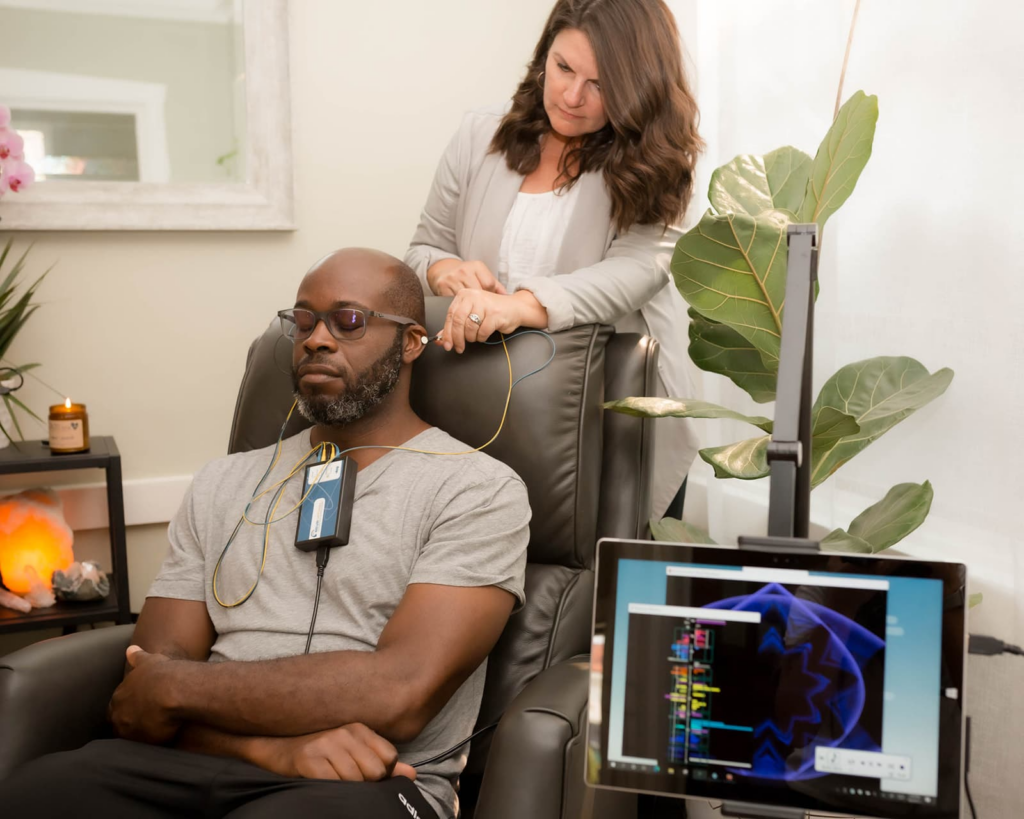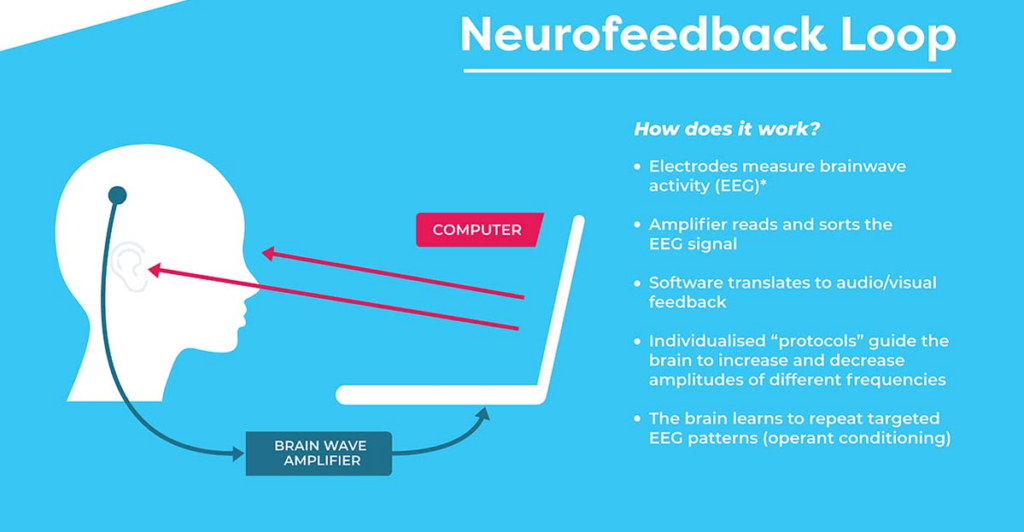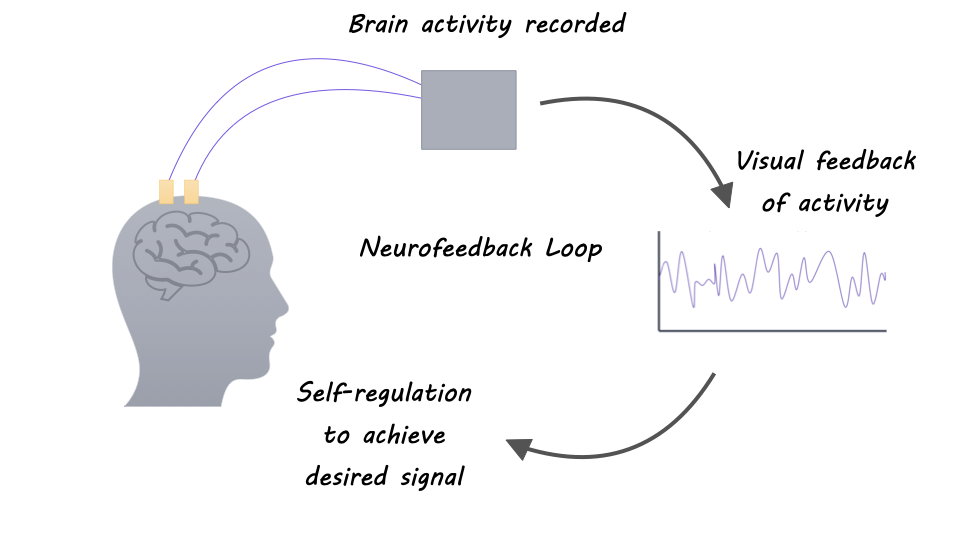
Neurofeedback, which concentrates on brain activity, has gained popularity as a non-invasive method for improving different aspects of cognitive functioning and mental health. As interest in this technique grows, people are asking when the best age to start training with neurofeedback.
What Is The Science behind Neurofeedback?
Neurofeedback uses real-time brainwave monitoring to train self-regulation, aiming to optimize brain function by reinforcing desired neural patterns.
Understanding how this process works is very important. Neurofeedback is based on principles where people are taught to self-regulate their brain activities through real-time feedback.
During sessions, sensors are placed on the scalp to pick up brainwave patterns, which are shown on a screen or monitor. Participants are directed towards altering these patterns using various exercises and activities.
You have to try and train your brainwaves to produce better waves associated with concentration and relaxation. Over time, such training leads to permanent alterations in brain functions and actions.
Can One Try Neurofeedback in Childhood?
Yes, neurofeedback can be used in childhood, often to address ADHD or anxiety, but should be supervised by a qualified professional.
This period is always seen as the best time for neurofeedback given the high levels of plasticity exhibited by a child’s mind. Children’s minds continually develop new neural connections hence they are more receptive to interventions aimed at shaping their brains’ functionality.
For children diagnosed with attention deficit hyperactivity disorder (ADHD), autism spectrum disorders, or learning disabilities, there have been promising outcomes from using neurofeedback. It may enhance focus, reduce impulsivity and improve overall cognition.
Nonetheless, it is important to caution that the therapy protocols for children should be cautiously developed and implemented by trained personnel. The activities and feedback must be suitable for the age of the child.
Can Adolescents Try The Therapy?
Yes, neurofeedback can benefit adolescents by improving emotional regulation, anxiety, and concentration, leveraging their higher cognitive maturity for effective outcomes.
During adolescence, there are major changes in the brain of a child. This phase of neural reorganization provides both hurdles and opportunities for neurofeedback interventions.
This alternative modality may be crucial in helping teenagers develop better stress management skills and enhancing their ability to concentrate on academics. Moreover, individuals at this age deal with the intricate web of emotions.
An advantage of implementing neurofeedback at this stage of life is that teenagers may typically have higher cognitive maturity levels compared to younger children. So practitioners can use complex training protocols that could lead to faster progress.
Is Neurofeedback Useful for Adults?

Yes, neurofeedback is useful for adults, aiding in managing stress, anxiety, depression, and improving cognitive function and emotional regulation.
Contrary to common belief, an adult’s brain continues to change throughout the lifetime. Adults may still gain extensively by undergoing neurofeedback training. For some grown-ups, this therapy becomes a tool to resolve mental issues and enhance cognitive performance.
Adults may find this alternative modality especially attractive as a non-drug-based alternative. This could lead to sustainable results and empower the patients.
Moreover, adults have better self-awareness and can give more detailed accounts of their experiences during training.
Can Neurofeedback Work for Older Adults?
Yes, neurofeedback can benefit older adults by enhancing cognitive function, reducing anxiety, and improving emotional regulation, though results vary.
As people grow older, they become more interested in ways through which they can retain their cognitive skills and prevent age-related decline. This therapy can offer an opportunity in this area.
Thus therapy can help with memory enhancement and increased attention control in older adults. It can deal with age-related deficits to treat memory loss associated with aging.
For elderly individuals, this modality can act as a fun activity that helps maintain healthy brain activity. Therefore, this kind of training enhances mental engagement leading to feelings of accomplishment.
Is Neurofeedback Worth the Money?
Neurofeedback may be worth the money for some, but results vary, and its effectiveness and cost-benefit ratio can differ.
For patients interested in non-invasive alternatives for ADHD, anxiety, depression, PTSD, etc., neurofeedback may become an investment. It is an approach that personalizes brain training, which often results in better cognitive abilities and improved emotional control.
Its effectiveness differs but it can cost a lot of money. Investigating practitioners’ qualifications combined with their success records may help determine their value.
When is the Best Time of Day for Neurofeedback?
The best time for neurofeedback is when you’re relaxed and focused, often in the morning or early afternoon for optimal results.
The best time for neurofeedback sessions depends on individuals’ schedules and preferences. Usually morning sessions up until early afternoon are preferable since this is when the brain is alert and receptive to training exercises.
The efficiency of this therapy can thus be enhanced by avoiding periods when you feel very tired, hungry, or extremely stressed out.
How Many Times a Week Should I Do Neurofeedback?

Typically, neurofeedback is recommended 2-3 times a week. The exact frequency depends on individual needs and treatment goals.
Neurofeedback is best done 2-3 times a week at the beginning to achieve the best results. This rate helps the brain learn new patterns and hold onto them better. As improvement occurs, the total number of sessions can decrease.
They range from twenty to forty sessions, depending on an individual’s case and goals.
Does Neurofeedback Help with Brain Inflammation?
Neurofeedback primarily targets brain activity patterns, but evidence supporting its effectiveness for brain inflammation is limited and inconclusive.
Whether it directly affects inflammation of the brain is still unclear because neurofeedback primarily focuses on enhancing brain function and regulating neural activity. Other research, however, suggests that improved self-regulation and resilience may reduce symptoms related to inflammation.
However, this approach should be combined with other treatment modalities.
Who Is A Good Candidate For Neurofeedback?
Good candidates for neurofeedback are individuals with anxiety, ADHD, depression, or other conditions affecting brain function and self-regulation.
Good candidates for neurofeedback include those having conditions like ADHD, anxiety, depression, PTSD, and sleep disorders. It also has benefits for cognitive enhancement and stress management.
The right candidate must agree to go through therapy regularly and adhere to all advice given by their practitioner during the treatment process.
Conclusion
The right time for this therapy depends on personal circumstances and needs. Early intervention can be highly beneficial however there are potential advantages at all stages of life. Even though one’s mind alters throughout their lifetime most people still have room for change with the help of this therapy! Neurfoeedback’s ‘perfect time’ comes when one is ready and willing enough to engage themselves in brain training.
